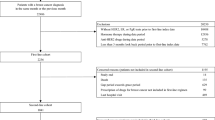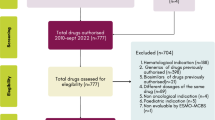Abstract
Introduction
Primary objective of the study was to assess the relative weighting between benefit in survival time (SV), benefit in quality of life (QoL) and willingness to experience adverse events (AEs), in patient preferences for chemotherapy treatment.
Materials and methods
We included cancer patients with current or past systemic treatment of cancer (STC) as well as physicians placed as hypothetical patients. Participants filled a choice-based conjoint analysis questionnaire with 19 choices among three STC scenarios with variable amounts of benefit in SV or QoL and different types AEs.
Results
One hundred patients (50 on curative and 50 on palliative intention treatment) and 114 physicians (61 oncologists and 53 non-oncologists) were included and asked about their preferred chemotherapy treatment. The relative weighting (sum 100%) of SV–QoL–AEs for making the choice in the 100 patients was SV35%–CV33%–AEs31% what was not significantly different from a random distribution (Goodness of fit Chi square P = 0.91) just as it was not for both subgroups, palliative (SV37%–QoL29%–AEs34%; GoF Chi square P = 0.55) and curative (SV34%–QoL36%–AEs30%; GoF Chi square P = 0.73) treatment. The observed distribution in the group of 114 physicians (SV46%–QoL31%–AEs23%) was significantly different from a random distribution (GoF Chi square P = 0.018) just as it was for both subgroups, medical oncologists (SV48%-QoL29%-AEs23%; GoF Chi square P = 0.006) and non-medical oncologists (SV44%–QoL33%–AEs23%; GoF Chi square P = 0.04).
Conclusions
The three attributes (SV, QoL, and AEs) are considered in the same way by cancer patients to make choices on their STC. On the contrary, when placed as hypothetical patients, physicians prefer for themselves those treatments that provide more SV.




Similar content being viewed by others
References
Ho M, Saha A, McCleary KK, et al. A Framework for incorporating patient preferences regarding benefits and risks into regulatory assessment of medical technologies. Value Health. 2016;19(6):746–50.
Allen JD, Stewart MD, Roberts SA, Sigal EV. The value of addressing patient preferences. Value Health. 2017;20(2):283–5.
Perfetto EM, Oehrlein EM, Boutin M, Reid S, Gascho E. Value to whom? the patient voice in the value discussion. Value Health. 2017;20(2):286–91.
Collins DC, Sundar R, Lim JSJ, Yap TA. Towards precision medicine in the clinic: from biomarker discovery to novel therapeutics. Trends Pharmacol Sci. 2017;38(1):25–40.
Arnedos M, Soria JC, Andre F, Tursz T. Personalized treatments of cancer patients: a reality in daily practice, a costly dream or a shared vision of the future from the oncology community? Cancer Treat Rev. 2014;40(10):1192–8.
Adunlin G, Diaby V, Montero AJ, Xiao H. Multicriteria decision analysis in oncology. Health Expect. 2015;18(6):1812–26.
Blinman P, King M, Norman R, Viney R, Stockler MR. Preferences for cancer treatments: an overview of methods and applications in oncology. Annals Oncol. 2012;23(5):1104–10.
Valentí V, Ramos J, Pérez C, et al. Adverse events from systemic treatment of cancer and patient-reported quality of life. JCSO. 2017;15(5):e256–e262262.
Ryan M, Farrar S. Using conjoint analysis to elicit preferences for health care. BMJ. 2000;320(7248):1530–3.
Beusterien K, Grinspan J, Kuchuk I, Mazzarello S, Dent S, Gertler S, Bouganim N, Vandermeer L, Clemons M. Use of conjoint analysis to assess breast cancer patient preferences for chemotherapy side effects. Oncologist. 2014;19(2):127–34.
Weinstein MC, Torrance G, McGuire A. QALYs: the basics. Value Health. 2009;12(Suppl 1):S5–9.
Woodward RM, Menzin J, Neumann PJ. Quality-adjusted life years in cancer: pros, cons, and alternatives. Eur J Cancer Care (Engl). 2013;22(1):12–9.
Kozminski MA, Neumann PJ, Nadler ES, Jankovic A, Ubel PA. How long and how well: oncologists’ attitudes toward the relative value of life-prolonging v. quality of life-enhancing treatments. Med Decis Mak. 2011;31(3):380–5.
Greenberg D, Hammerman A, Vinker S, Shani A, Yermiahu Y, Neumann PJ. Which is more valuable, longer survival or better quality of life? Israeli oncologists’ and family physicians’ attitudes toward the relative value of new cancer and congestive heart failure interventions. Value Health. 2013;16(5):842–7.
Dilla T, Lizan L, Paz S, et al. Do new cancer drugs offer good value for money? The perspectives of oncologists, health care policy makers, patients, and the general population. Patient Prefer Adherence. 2015;10:1–7.
Broekhuizen H, IJzerman MJ, Hauber AB, Groothuis-Oudshoorn CGM. Weighing clinical evidence using patient preferences: an application of probabilistic multi-criteria decision analysis. Pharmacoeconomics. 2017;35(3):259–69.
EMA. Reflection paper on benefit-risk assessment methods in the context of the evaluation of marketing authorisation applications of medical products for human use: report of the CHMP working group on benefit-risk assessment methods. London; 2008. https://www.emea.europa.eu/docs/en_GB/document_library/Regulatory_and_procedural_guideline/2010/01/WC500069634.pdf. Accessed 6 Dec 2016.
Arnold D, Girling A, Stevens A, Lilford R. Comparison of direct and indirect methods of estimating health state utilities for resource allocation: review and empirical analysis. BMJ. 2009;339:b2688.
Dolan P. Utilitarianism and the measurement and aggregation of quality–adjusted life years. Health Care Anal. 2001;9(1):65–766.
Kaplan RM, Babad YM. Balancing influence between actors in healthcare decision making. BMC Health Serv Res. 2011;11:85.
Funding
“Associació Oncológica Dr Amadeu Pelegrí” (www.aodapelegri.com), which is a charitable association leaded by cancer patients based in Salou (Spain).
Author information
Authors and Affiliations
Corresponding author
Ethics declarations
Conflict of interest
The authors declare that they have no conflict of interest regarding the publication of this article.
Ethical approval
The study was approved by the Institutional Review Board of the participant centers.
Informed consent
All the patients signed written informed consent before their inclusion in the study.
Additional information
Publisher's Note
Springer Nature remains neutral with regard to jurisdictional claims in published maps and institutional affiliations.
Rights and permissions
About this article
Cite this article
Valentí, V., Ramos, J., Pérez, C. et al. Increased survival time or better quality of life? Trade-off between benefits and adverse events in the systemic treatment of cancer. Clin Transl Oncol 22, 935–942 (2020). https://doi.org/10.1007/s12094-019-02216-6
Received:
Accepted:
Published:
Issue Date:
DOI: https://doi.org/10.1007/s12094-019-02216-6




